

Interactive computing techniques are now recognised as a vital tool in the computer-aided design environment. In many research and development areas, it is impossible to formulate problems so that the best result can be obtained. Increasingly, the intervention of a designer is necessary to select a preferred solution which is of necessity a compromise between a number of competing factors. In this situation, the designer must be free to extract and supply information from and to a computer program on a short timescale; seconds, and fractions of seconds, are the order of the day, rather than the hours of batch computing turnround. Batch computing is, of course, still necessary for those problems which are too large for interactive working.
The Interactive Computing Facility {ICF) project was initiated in 1976 to satisfy these new computing needs. There are now 1700 registered users on the 21 installed ICF machines (two DEC10, twelve GEC 4000 series, and nine PRIME 550 or 750); Fig 3.1 shows the distribution of these computers (and others only part-owned by ICF) in the UK. The interactive power supplied initially by the DE10 computers is now being replaced by that of the more modern Multi-User Minicomputers (MUMs). The installation phase for these MUMs was almost completed by the end of the year. Most of these computers have now been linked to each other and to SRC's powerful batch computers, and the benefits of networking are being felt.
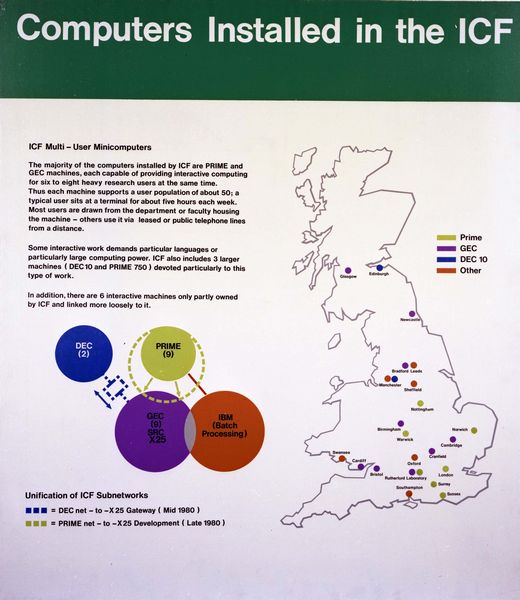
Provision of computing hardware itself is not enough. One of the major aims of the ICF has been to reduce significantly the proportion of research effort in research groups which in the past has had to be devoted to programming. Operating systems for the standard ICF MUMs are developed and supported from RAL; each MUM runs the same operating system and basic software (eg graphics and numerical libraries) as the others in its range. In the applications areas, too, ICF has taken an initiative; nine Special Interest Groups working in various areas have suggested programmes to ICF and had them approved. Many of these are already producing quality applications software and are supporting SRC grant-holders. Applications software development is now becoming increasingly important within ICF.
The ICF programme provides facilities in five major areas:
This year has seen the beginning of the run-down of the (36-bit) DEC10 computing service, which has been in operation for many years. The MUM installation programme is now well advanced, with only two more machines to be installed. Some experience has also been gained on single-user minicomputers (SUMs) such as the IBM 5100 and Tektronix 4051. The end of the year saw the delivery of the first of a new, much more powerful SUM - the Three Rivers Corporation's PERQ. This machine provides to one user computing power, memory, and disc space, comparable to a small MUM coupled to a high-quality raster graphics display and input devices. It is expected that in a few years time computers such as the PERQ will be increasingly used to provide a high-quality interactive service.
The DEC10 computers at ERCC and UMIST have both been well-loaded during the year. In line with ICF policy of concentrating DEC10 hardware and support at one site, the KI-10 processor at ERCC was upgraded to a KL-10 in September; the UMIST DEC service will be withdrawn by mid-1981. The ERCC machine is to serve those application areas which are heavily dependent on DEC10 features, such as Artificial Intelligence and some aspects of Electronic Circuit Design.
Three more ICF-owned GEC computers were installed this year - at Cardiff, Bradford and Birmingham. Nine GEC machines are now providing an interactive service. Central support of the operating system is working well, being greatly aided by the excellent networking facilities developed for the GEC machines. Eight other GEC computers are linked to the ICF network and use the ICF operating system.
There are now seven ICF-purchased PRIME computers installed; four of these were brought into service during the year (at City University, Surrey, University College London and Warwick). In addition, both PRIME 400 computers at RAL have been upgraded to PRIME 750s. Two of the University-owned machines upgraded by ICF funds are also PRIMEs and run standard ICF operating systems. Usage of all the machines has steadily grown over the year. One of the RAL PRIME computers has a Floating Point Systems APl20B array processor attached. This can give a significant improvement in speed on an interactive timescale and is used by a number of groups.
The PRIME computers will in future be supported by staff at UMIST, and the transfer of work from RAL has begun. Initially only PRIME user support services will be centred at UMIST, but in 1981 support of the systems software will be concentrated there also.
In addition to the two university-owned PRIMEs mentioned above which were upgraded with ICF funds, six other computers were also enhanced. These machines - three DEC PDP 11/45s, two DEC VAX /780s and an Interdata 8/32 - are continuing to provide ,interactive service to SRC users on the ICF share of the machines. Support of these machines by ICF is beginning to be run down with the completion of the MUM installation programme.
A loan pool of terminals and communications equipment has been set up. The terminal pool is now 650 strong and includes a wide range of devices. These include colour raster displays, refreshed graphics units, Tektronix storage tubes and Benson plotters, as well as non-graphical display terminals such as visual display units and fast serial printers. Local pools of terminals and plotters are provided at each of the ICF sites; these are used by a wide range of users and are not normally allocated to specific projects. In cases where grant-holders are not close to one of these local pools, devices (and links to the ICF computers) can be provided by ICF. In general, an ICF terminal is normally shared by three to four users, to make cost-effective use of SRC resources.
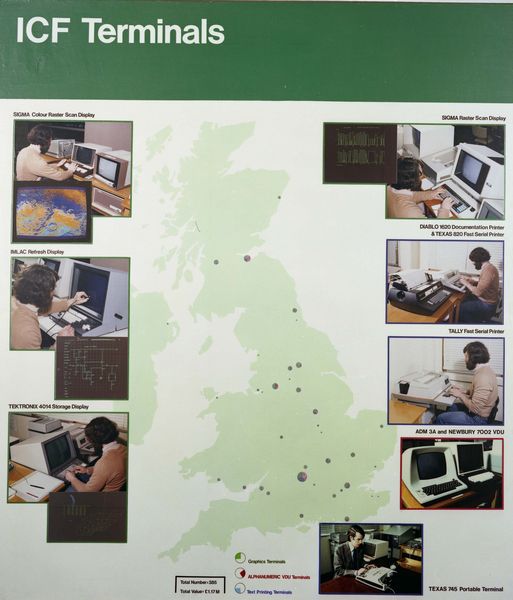
The GEC computers have been fully networked for some time, forming the SRCnet, and offering:
All these protocols use the SRC version of the standard X25 protocol. The DEC computers are linked to each other via DECnet (which does not use X25). A gateway to the SRC network has been provided this year which allows ITP and FTP to SRCnet machines. Remote job entry links will be provided in the first half of 1981; at the moment only restricted access is possible between DECnet and the SRC batch computers.
By the end of the year, withdrawal of the restrictive PRiMEnet links between the PRIME computers had begun. ITP and FTP codes have been developed at RAL and PRIME computers have been linked to the SRCnet; this transfer from PRiMEnet to SRCnet should be completed in 1981, together with RJE access to the central batch facilities.
It is certain that networking will have a profound effect on the way SRC provides and supports its computing service. Already on SRCnet new versions of the operating systems are easily distributed; in addition, applications software can now be similarly provided. Direct support of remote users from a central site is a reality, and remote access to specialised application software and technical support which may be available at only one site, say, can be provided. A new type of collaboration, on a single project between individuals scattered at several universities, has become possible.
Applications software has been supplied from a number of sources. Each of the major ICF machines (DEC, GEC, PRIME) is supplied with the NAG Library of numerical software and the G1NO-F library for graphics. In addition, the minimal 2D graphics package FINGS is available on the ICF MUMs. Other higher level graphics libraries such as GINOGRAF and GINOSURF are available.
For users with data management or access requirements, three major items of software are available on an RAL PRIME 750. These are STATUS, a text information retrieval system with good online retrieval facilities; PRIME DBMS which is a CODASYL standard database management system permitting both hierarchical and network type data structures; and MIDAS, a data management system which can be used to set up large files of data whose structure is not complex enough to warrant using a full DBMS.
Some interactive statistics programs are also available on ICF. These include GLIM, GENSTAT and SCSS on the RAL PRIME, and SCSS only on the ERCC DEC10. The text layout system RUNOFF is mounted on most ICF computers and is widely used for documentation production. More application-specific software is being provided by the ICF's Special Interest Groups (SIGs). All the SIGs have now presented their software development plans to the Interactive Computing Facilities Committee and received approval for three to five year programmes. The plans and achievements to date are described below.
The main aim here has been to develop a highly interactive language system called WPOP, based on the well-known POP-2 system. In addition, three dialects of LISP are maintained. Support for PROLOG, a language for programming in predicate calculus, was undertaken during the year.
This SIG reported to the Interactive Computing Facilities Committee during the year and the programme has not yet started. Major requirements were for a good interactive graphics environment; geometric modelling software; a computer-aided architectural design applications software suite; access to a number of database management systems (AESOP, GLIDE, RAPPORT) and the development of a new modular system called DBOS and the provision of a system tutor to guide new users through the software. Some of these activities will be undertaken as part of the Pre- and Post-Processing programme described below.
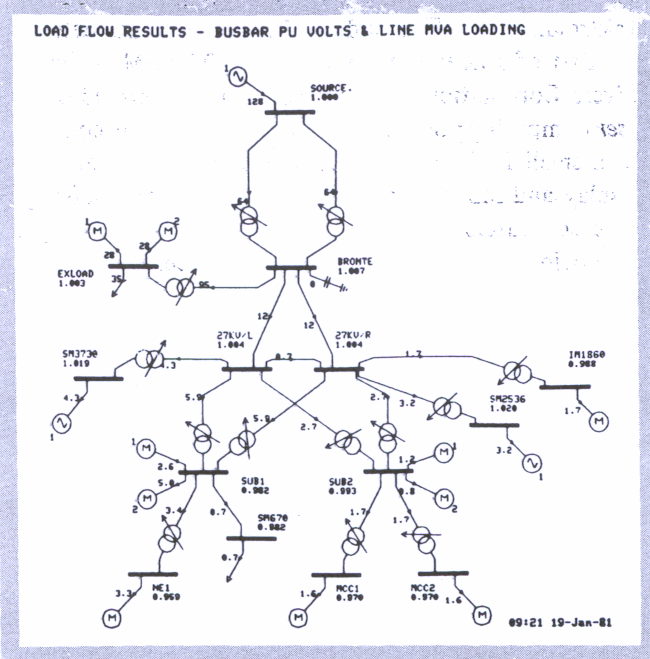
The UMIST Control Systems Design package has been made available on the UMIST DEC10. The Cambridge GEC 4070 now offers the multi-variable design system written there, and it has also been mounted on the UMIST DEC10. In addition, the ACSL simulation package has been obtained for the PRIME computers at Sussex, UMIST and Warwick, with support shared between SIG staff and staff at Sussex and Warwick. Work has also begun on the development of a library of subroutines for developing new Control Engineering software.
This is a very complex area; at the beginning of 1980 no less than 12 packages had been provided, in two main areas - Analogue Systems Analysis and Digital Systems Analysis. For analogue circuits, software is available for interactive small circuit analysis; large system analysis; some aspects of microwave engineering; system modelling and simulation; and a library of device and material characteristics. On the digital side, programs supplied cater for digital system specification; simulation and fault analysis; transient analysis of digital structures; integrated circuit design and layout; and guidance and implementation aids for microprocessors.
During the year three new packages have been mounted PCIRC, an interactive printed circuit board layout program (written at RAL); DIGSIM, a powerful statistical logic simulator; and STAB, a compiler-writing system which enables control strategies to be designed for digital hardware. Most of the group's efforts, however, have been directed to setting up and giving user courses on the software. Four NAP courses, two DDL and one DIGSIM courses have been given; more are planned for 1981. The major objective of the group for the future is the integration of the analysis software to form a cohesive design suite.
Much of the software now supported by the SIG was developed at RAL. One of the systems is GFUN3D, a magnet design package, which runs on the IBM batch computers and is interfaced by the interactive preprocessor THESEUS running on the ICF PRIME. The linear Poisson equation can be solved in 2 or 3 dimensions by the boundary integral method using programs BIM2D or BIM3D; BIM2D uses the PRIME array processor to give a useful interactive design tool. Finite element methods are used to solve the non-linear Poisson equation with the packages PE2D and TOSCA. During the year, work has been done on the PE2D program to extend its capabilities. Improved post-processing will be available in the first half of 1981, as the result of a collaboration between RAL, Imperial College and Infolytica Ltd. In addition, THESEUS has been interfaced to TOSCA and BIM3D. A number of user courses have been held during the year, and an open meeting was held in November.
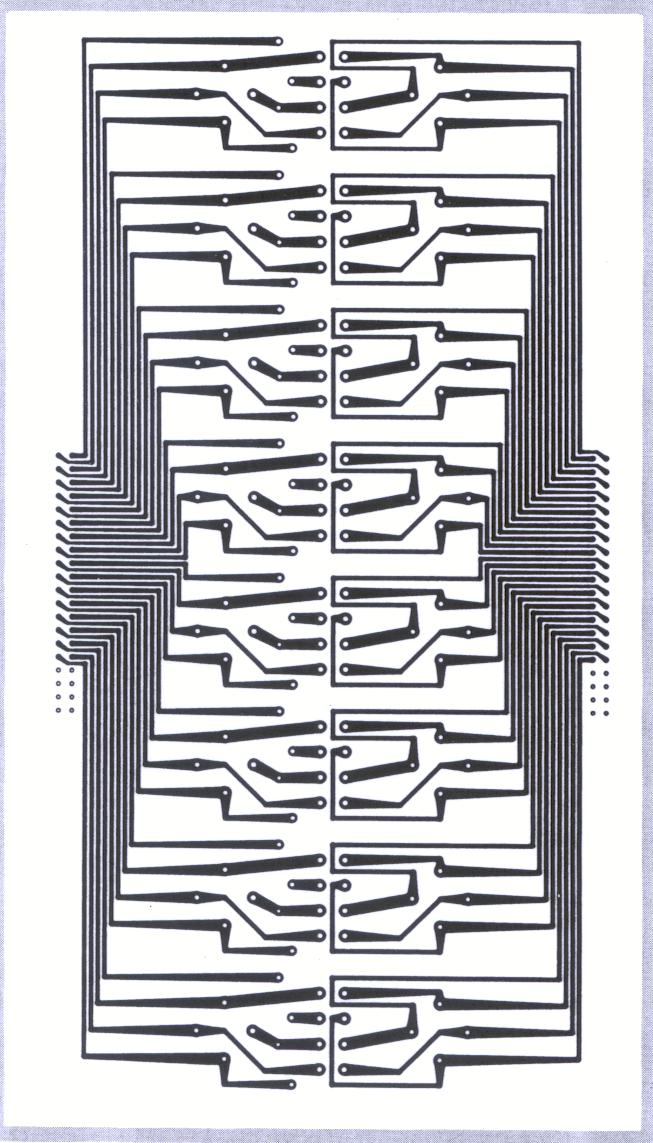
Users of Finite Element (FE) software fall roughly into two classes - designers and developers. The designers require the FE method as a tool, and from the considerable number of structural analysis packages available, the ASAS and BERSAFE programs were selected for support. Usage of these packages has steadily grown over the year. Developers require software which can be easily modified so that new types of analysis can be done; increasingly, these analyses are outside the structural analysis area where the FE method was originally developed. Indeed the technique is now recognised as a method for solving many types of partial differential equations, with users' requirements from Physics, Mathematics and Medicine as well as Engineering departments. To meet the requirements of the second group, an FE Library has been developed from an existing system and has been under continuous development throughout the year. Two one-week courses have been given (at Glasgow and Manchester): the courses give users hands-on experience of the FE Library and by the end of the week most users have made at least a start on solving their problems. The Library is available on GEC and PRIME computers as well as the batch IBM equipment.
One of the drawbacks of the Finite Element technique is the large quantity of input data required. The FEMGEN mesh generator has been obtained and interfaced to the packages and the FE Library. Some work has been done this year on making this interface program easier to use and more robust. A post-processor called FEMVIEW has been evaluated and will be providing a service in 1981. It is an extremely powerful viewing tool and will be an excellent result display and analysis tool.
The first in a series of one-day specialist meetings called Finite Element Colloquia was held in May. The first meeting - entitled Finite Elements in Fluids - was very successful with over a hundred participants from all over the UK.
The aim of this group is to obtain tools for the construction of interactive design programs. This involves the acquisition of general-purpose modules for interactive program construction, such as a command decoder, a modular database management system, and high-level graphics, as well as less generally applicable items such as mesh generators and geometric modellers. So far DBOS (a database management system) and SIMPLEPLCT (a library of Fortran routines for the swift production of good quality annotated graphs) have been provided. Much effort has been expended on the heart of a good interactive program - the development of man-machine interface software. The results of this work will become available in 1981.
Overall, the provision and support of more and better applications software is seen as the main growth point of ICF in the future.
The ICF has 1700 users and 650 terminals in 60 institutes using 27 computers, all distributed widely in the UK. While distributing computing power to the users provides a better interactive service, it can also create problems in management and support of the facilities. A prospective user will require advice on how to apply for time on the ICF machines, and how the software and services available can be best used for a particular problem; once authorised as a user, a suitable ICF machine (usually local to the user) must be selected, computing resources and filestore allocated, and access to the computer arranged via a suitable interactive terminal. Documentation must be supplied front-line user support is available from local computer managers; more expertise is available for the standard ICF MUMs from RAL. Advice on how to use the rapidly growing body of applications software is available, both from RAL and elsewhere. The aim of the ICF is to let the remote users have the feeling that they are remote only it terms of distance, not in terms of importance.
The Distributed Computing Systems (DCS) Programme has been co-ordinated and supported by RAL since January 1978. RAL staff have been engaged in promoting communication and co-operation between the 40 university projects funded by the DCS Programme as well as linking the university research with the industrial world. The precise mechanics of co-ordination are evolving as the programme develops, but the essential features are as set out below.
Within the programme, as its scope is very broad, the degree of co-ordination appropriate to each research project varies according to its nature. Effort is concentrated on th following aspects:
The DCS Programme also fosters industrial interest in the research with the objectives of promoting collaborative projects and facilitating a high degree of technology transfer. This is achieved via:
As of September 1979 there were 31 distinct projects within the DCS Programme representing an investment of £2.3 million. During the past year the SRC, acting on the DCS Panel's recommendations, awarded a further 13 grants and 6 senior visiting fellowships worth £263,000. During the year 7 grants terminated. A total of 53 grants has been awarded and there are now 41 distinct, active projects in the programme.
The SRC, in response to the DCS Panel's recommendations, has negotiated licence agreements for UNIX(TM) software (Western Electric Company) and the UCSD Pascal(TM) (Softech Microsystems Inc and the Regents of the University of California) software system. Licences for these systems are available to DCS investigators through the equipment pool. Support for these systems is provided by RAL staff.
During 1979/80, licences for Version 7 of UNIX were obtained. Effort was expended to implement Version 7 on the smaller computers from the DEC PDP11 range (eg 11/34) used by many projects in the programme, and to produce a polished product for distribution to DCS licence holders. The installation and maintenance of this software are supported by RAL.
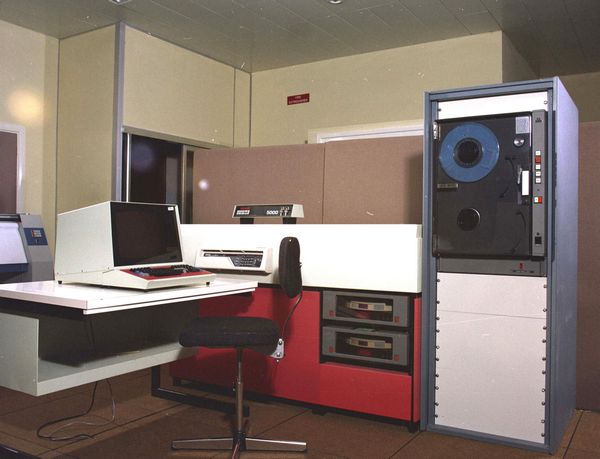
Work is almost complete on coupling the UNIX troff text formatting software to the SRC's FR80 microfilm recorder at RAL, to provide a pathway for the production of high quality papers and documentation (containing text in different fonts, mathematical notation and diagrams). The FR80 produces output on a variety of media including photographic paper (12 in wide), microfiche, 16 and 35 mm film (black and white or colour). There are already several DCS research groups awaiting the introduction of this service as the number of users is likely to increase substantially with the advent of the British Telecom PSS network and the proposed expansion of SRC's own X25 network, when it will become feasible for investigators to easily transmit text to the RAL facilities.
The University of Cambridge has been developing a wide-band digital communication ring over the last few years. Much interest in the Cambridge Ring, as it is known, has been expressed by research groups within and outside the DCS programme and many groups have expressed the desire to obtain first-hand experience of this communications technology. These requests have come from both groups whose research interests lie in the field of communications protocols, protocol performance, etc and also from groups looking for a communications technology on which to build a distributed computing system.
A small number of research groups have undertaken the construction of Cambridge Ring equipment to the Cambridge designs, but many other groups do not have the resources to undertake such a task. The DCS Panel recognised that to make Cambridge Ring equipment available to DCS investigators would have a significant impact on many research projects and would lead to a broadening of the applications of, and experience of using, Cambridge Rings. Funds were made available for the construction of a batch of six Cambridge Rings of four nodes each to the Cambridge Mark 2 design. The Rings were constructed at RAL and have been successfully installed in DCS projects.
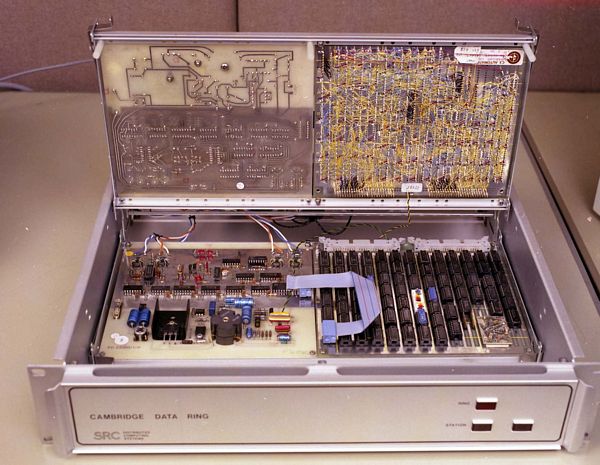
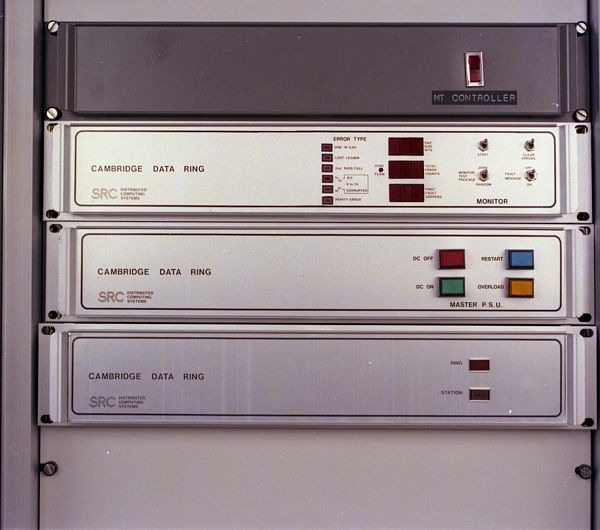
The demand for the loan of Cambridge Ring equipment from research groups within the DCS programme was considerably in excess of the supply and so the DCS Panel, recognising the opportunity to foster the take-up of this innovation by industry, sought funds from the SRC to place a contract with UK industry for the construction of further ring hardware. The DCS Programme has therefore ordered ten Rings, of six nodes each, from Logica VTS Ltd.